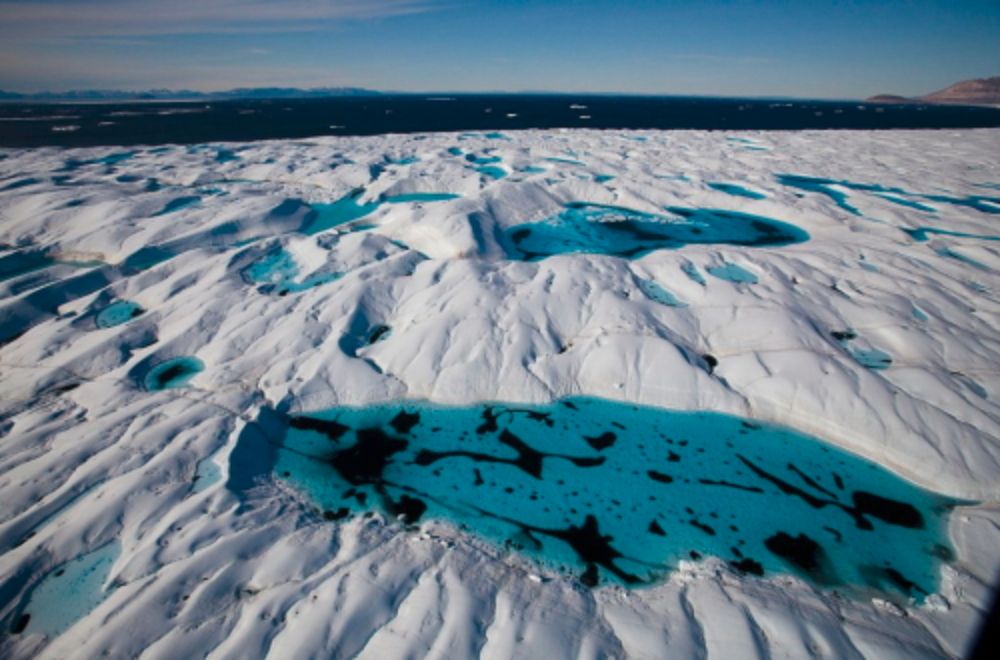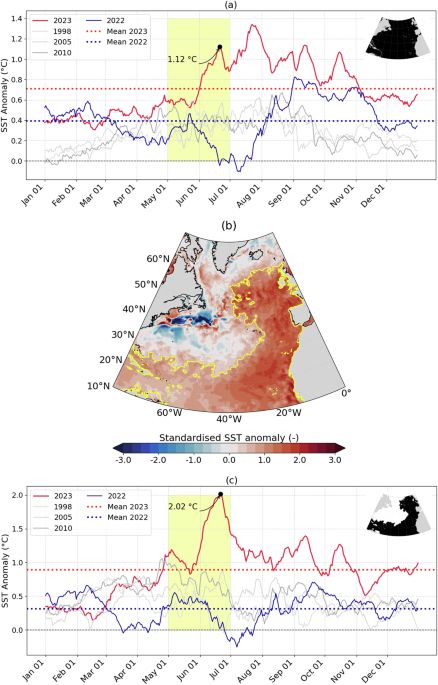Merci pour cet article Nicolas!
21.10.2025 11:17 — 👍 0 🔁 0 💬 0 📌 0

Polar stereographic map of sea surface temperature trends for Octobers from 1979 to 2024. Red shading is shown for warming trends, and blue shading is shown for cooling trends. All areas of the ocean are observing warming.
Recent trends in sea surface temperatures show warming around the perimeter of the #Arctic Ocean in October. This is especially evident in areas with decreasing sea ice concentration/thickness (e.g., Chukchi Sea).
For more information: doi.org/10.25923/9z9...
17.10.2025 23:42 — 👍 85 🔁 22 💬 4 📌 0
En 50 ans la taille moyenne des populations d’animaux sauvages suivies a diminué de 73 % dans le monde et 35% en Eurasia selon @wwf.eu
Or un projet de décret vise à amoindrir la protection des espèces (toutees, pas que le loup)
Explication et lien pour vous exprimer jusqu'au 19 octobre⤵️
17.10.2025 09:20 — 👍 31 🔁 21 💬 0 📌 0
Réchauffement climatique et variabilité interne du climat. Comme quoi 2023-2024 n’est pas « uncharted » mais surtout une combinaison chaudes des 3 bassins océaniques sur cette tendance de long terme.
16.10.2025 04:55 — 👍 4 🔁 0 💬 0 📌 0

Dans une vue + large, le Pacifique reste a des niveaux très élevées ainsi que toute la zone Arctique et l’Atl.tropical.
Sans préjugés des conditions atmosphériques, cela reste un réservoir d’énergie/d’humidité conséquents et une souffrance pour tous les écosystèmes
15.10.2025 17:09 — 👍 2 🔁 0 💬 0 📌 0

Des conditions anticycloniques persistantes, du ☀️, peu de vents. Le cocktail parfait pour les vagues de chaleur marine.
Phénomène courant en été, ces extrêmes touchent la Méd aussi à l’automne (comme en 2022).
15.10.2025 17:05 — 👍 8 🔁 2 💬 1 📌 1

Line graph time series of 2025's daily 2-m temperature in the Arctic compared to each year from 1958 through 2024. There is a long-term warming trend for every day of the year. There is also large interannual variability and a clear seasonal cycle.
Record high temperatures are currently being set across the northernmost portions of the #Arctic. In fact, it is effectively ice-free on the Atlantic side of the Arctic all the way up to about 85°N latitude! This includes record low sea ice around Svalbard.
Graphic by zacklabe.com/arctic-tempe...
11.10.2025 00:57 — 👍 201 🔁 98 💬 8 📌 18
🔴🌀 La tempête tropicale #Jerry passe au plus près des Antilles. La Guadeloupe est passée en #VigilanceRouge fortes pluies et orages. Il est tombé 100 à 150 mm en 3 h sur une bonne partie de la Grande-Terre. Les pluies vont perdurer encore plusieurs heures. meteofrance.gp/fr/vigilance
10.10.2025 07:30 — 👍 21 🔁 4 💬 0 📌 0
🌀Je crois que c'est la première fois que je vois ça : l'agence météorologique espagnole nomme non pas un minimum dépressionnaire en Pmer, mais baptise de façon explicite une goutte froide d'altitude (ou dana, ou cutt-off low) en raison de probables futures intempéries pluvieuses : "la dana" #Alice.
07.10.2025 12:15 — 👍 19 🔁 8 💬 4 📌 1
Lien alimentation-santé- environnement:
L'étude "Eat-Lancet » établit que les systèmes alimentaires sont un facteur majeur de dégradation de l’environnement et de hausse des maladies chroniques et des inégalités. Elle suggère à la fois un régime moins carné et un meilleur partage de la valeur"⤵️
04.10.2025 04:37 — 👍 30 🔁 15 💬 0 📌 0

Près de 50 m² de nature détruits chaque seconde : visualisez le bétonnage à grande échelle de l’Europe
Hangars, usines géantes, villas… Pixel après pixel, l’analyse inédite d’images aériennes de notre enquête « Green to Grey » dévoile les causes et l’ampleur de l’artificialisation qui transforme le con...
Chaque année, 1500 km2 de nature et de terres agricoles disparaissent sous les constructions humaines en Europe
"On pourrait croire que l’artificialisation est d’abord tirée par la croissance démographique. Mais, en Europe le principal moteur est la richesse"
Merci @raphaelleaubert.bsky.social
02.10.2025 06:21 — 👍 51 🔁 29 💬 0 📌 2

Multiple models, one forest: a Bayesian perspective.
Led by Nicolas Picard, we combined climate-sensitive forest models to see where they agree - and where they don’t.
A better way to predict European beech’s future in a changing climate.
Read more 👉 authors.elsevier.com/c/1lrB815DJ-...
27.09.2025 13:10 — 👍 5 🔁 1 💬 0 📌 0

Racontons ce qui se construit. Pas seulement ce qui s’effondre
Financement participatif organisé par Expertises climat - Jusqu'au 8 octobre inclus, 1% for the Planet double vos dons
L'asso Expertises Climat vise à faire du lien entre chercheurs et médias pour améliorer le traitement des enjeux environnementaux.
Elle lance une campagne de crowdfunding pour raconter des solutions / initiatives dans les médias.
Pr en savoir + et/ou participer ⬇
www.helloasso.com/associations...
20.09.2025 13:04 — 👍 36 🔁 21 💬 1 📌 0

L’océan face au changement climatique | Météo-France
En absorbant la chaleur, l'océan a un important effet modérateur sur le climat et ses changements. Il est aussi particulièrement vulnérable au réchauffement climatique global et à l'augmentation du co...
La Journée mondiale de la mer est aujourd'hui.
Pour l'occasion, un article grand public sur l'importance des océans dans le système climatique :
- une augmentation de l'acidité
- des extrêmes chauds + intenses et + chauds
- un niveau qui ↗️
Avec des conséquences désastreuses
👇
tinyurl.com/bdcmx2hb
25.09.2025 08:10 — 👍 12 🔁 5 💬 0 📌 0

❓Have you registered for the #ClimateCoffee on Ocean Heat Content (OHC), which is a key indicator of climate change?
✅No worries if you haven't, Register here:
www.eventbrite.dk/e/...
@MAIAresilience
👥See you on 22 May 2025 | 10:00 - 10:45 CEST
24.09.2025 15:59 — 👍 4 🔁 4 💬 0 📌 0
Attendu ce matin : "avec les T°C de la Méditerranée, nous nous attendions à des événements de ce type jusqu'à la fin de l'année".
Oui les SSTs amplifient les evts pluvieux en Med, en ce moment +2/+3°C MAIS c'est bien l'instabilité atmosphérique qui pilote. Prévision impossible à long terme.
22.09.2025 07:33 — 👍 9 🔁 2 💬 0 📌 0
However, I agree with you, we do not know (yet?) why this event lasted so long and what the probability is over the total duration.
By the way, I’m not downplaying the role of aerosols (sulphur, dust, …), I'm just surprised at how this narrative has been imposed, hidding other main factors
21.09.2025 23:23 — 👍 0 🔁 0 💬 0 📌 0

Thanks for your detailed and interesting/informative thread.
I’ll simply answer that we looked at this event compared to the 19th century and found this is a 1-in-10 year event or 1-in-100 event dependent on the region. This is a rare but plausible/excepted event at current global warming level
21.09.2025 23:16 — 👍 0 🔁 0 💬 1 📌 0
The concept of trying to implement geoengineering solutions to #climate change is like trying to design a complicated, expensive, unreliable helmet while you're still hitting yourself in the head with a 2x4.
21.09.2025 17:49 — 👍 390 🔁 96 💬 17 📌 7
You avoid most of comment… stratification driven by anthropogenic emissions is not short-lived…
On the other hand I gave you papers attributing extreme SSTs to IV+CC (and showing negligible IMO2020 effect), did you have one attributing them to IMO2020?
21.09.2025 12:26 — 👍 0 🔁 0 💬 1 📌 0
My point is that communicator or geo-engineering enthusiast are not doing science but using strawman argument. As scientist we have to be rigourous. Knowing the time response of IMO2020, the real game changer is stratif which has a large scale and profound impact on heat content and ocean response.
21.09.2025 12:11 — 👍 1 🔁 0 💬 1 📌 0
Yes IMO2020 has a negligible impact, Matt’s paper is clear on that plus this one : agupubs.onlinelibrary.wiley.com/doi/10.1029/...
Everyone should be careful in pointing out processes that are part of a climate response rather than a climate forcings.
21.09.2025 12:07 — 👍 0 🔁 0 💬 1 📌 0
There is definitely a need for studying imbalance but coïncidence is not science.
5 articles were published in 2025 on SST in the N. Atlantic or globally, and all showed that this was driven by IV + CC. For me, stratification is a game changer and not a coincidence.
21.09.2025 08:44 — 👍 0 🔁 0 💬 1 📌 0
I’m sure you already the paper from Matt which has the same conclusions. This story is a defeat of science against communicators…
21.09.2025 07:36 — 👍 2 🔁 0 💬 1 📌 0
Simulate a decennial event with couples models (with aérosols reductions taken into account in SSPs) are more solid evidence than a correlation between two maps
21.09.2025 07:26 — 👍 0 🔁 0 💬 1 📌 0

Global map showing sea surface temperature anomalies in August 2025 relative to 1982 to 2010. Most areas are warmer than average. Red is shown for warmer sea surface temperatures, and blue is shown for colder sea surface temperatures. Data is from NOAA OISSTv2.1.
The massive extreme marine heatwave continues to stretch across the entire northern Pacific Ocean. In fact, the magnitude of the sea surface temperature anomalies even grew in August 2025 compared to earlier in the summer. Yikes... 🫠
Data from OISSTv2.1 (psl.noaa.gov/data/gridded...). 🌊
11.09.2025 16:38 — 👍 192 🔁 100 💬 8 📌 9
Geologist, paleobiologist, @CNRS.fr research scientist, co-director of the Climate team at CEREGE @climatecerege.bsky.social, PI of ERC-funded
@dispersal-erc.bsky.social project
Artist and nature lover - celebrating the wildlife and wild landscapes of northern England. Also keen on rocks and fossils. Art and photos are my own unless stated otherwise. Occasionally I write poetry - apologies in advance.
Journaliste Les Echos ║Sciences, tech mais aussi BD & illustrations
Journaliste @sciences_avenir, rédactrice en chef adjointe du pôle web. Autrice du livre Notre air est-il respirable ? @editionsquae. lloume@sciencesetavenir.fr
Use the feed below and get first-hand news in climate sciences, directly from:
13,700+ scientists, sci comms and reporters
🌎 Climate Change Sciences 🌎
https://bsky.app/profile/did:plc:rprxe2jmbftg3ajamqhrgxji/feed/aaamxvffjaodq
I maek typos
Journaliste scientifique / Rédactrice en chef Revue Pharma - passée par @leQdM @allodocteurs @CNRS @LelephantRevue
Economist, studying crime and gender, associate prof at the University of Bristol. French. Author of "La fabrique des jugements".
https://sites.google.com/site/arnaudphilippe11/
Journaliste Ouest-France, passionné de #sciences, parle un peu de #complotisme et de vie de bureau. #Hellfest addict 🤘 Bénévole à @lachance-media.bsky.social
Journaliste RTBF
💻 Rédaction fact-checking - data - OSINT - « Décrypte »
📲 https://www.rtbf.be/auteur/guillaume-woelfle-30
🇧🇪 Bruxelles
Senior research scientist at INRAE, France @inrae-france.bsky.social and @univparissaclay.bsky.social. All views are my own.
Interested in (food) rheology, interfacial phenomena, soft matter, flows, food oral processing.
La Fondation pour la recherche sur la biodiversité (FRB) est une plateforme entre les différents acteurs scientifiques et les acteurs de la société sur la biodiversité 🌱
https://www.fondationbiodiversite.fr/
Journaliste indépendant. J'enquête sur l'extrême droite et la police.
Team @reflets.info
Co-créateur de Indextreme.fr
Site : ricardoparreira.com
Fruit de la passion...
Professeur de lettres modernes pendant 36 ans.
Chevalier des Palmes Académiques.
Amoureux du beau et de l'intelligence.
Le Maroc au coeur.
Et puis la Californie.
Soutien et ami de Najat Vallaud-Belkacem...
سلام
Journaliste environnement @liberation.fr - "François Sarano, réconcilier les hommes avec la vie sauvage" (Actes Sud)
Researching & Reporting on Food’s Impact on the Climate
https://open.substack.com/pub/progressispurpose
┣ research-research: crop ecology, 🌻, {🌾+☘️}
┃ INRAE, FR https://orcid.org/0000-0001-7225-936X
┣ research-creation: creative coding, ink
┃ http://art.casadebaig.net
┣ #rstats, and 🚲 enthusiast
Associate Professor of Public Policy, Politics, and Education @UVA.
I share social science.
Advancing transformative climate solutions. Analysis, insight, and research on climate change from the Climate, Economics and Finance team at the World Resources Institute.

















